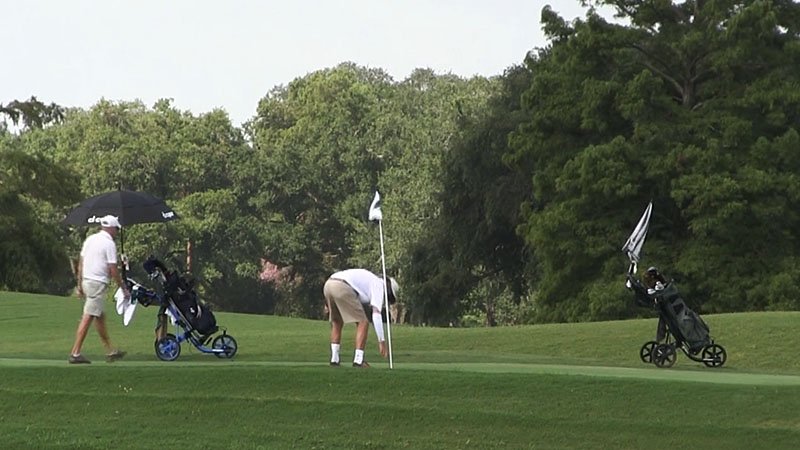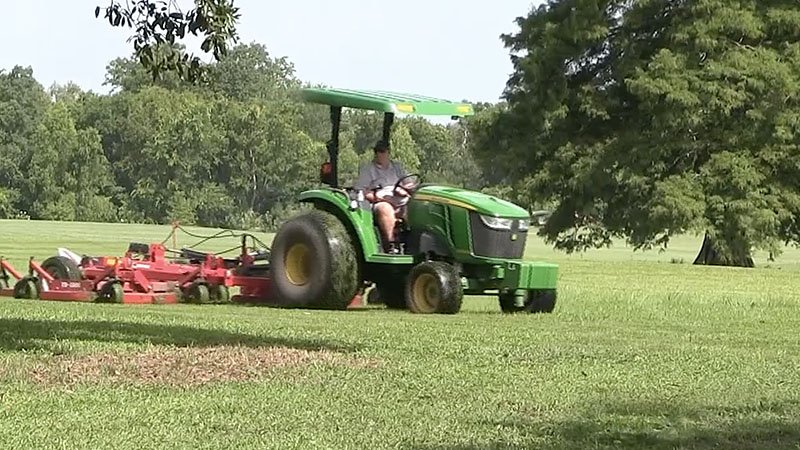
That unfamiliar noise emanating from golf shops nationwide has been the sound of cash registers ringing. Golf courses from coast to coast are enjoying a boon thanks to a global health crisis that has all but eliminated many other recreational activities.
That rise in play has helped create stress for superintendents, many of whom are eagerly anticipating an end to the golf season.
How the golf business was impacted at the onset of the pandemic varied state-by-state, county-by-county and city-by-city. Some remained open and unrestricted while others were closed for a short time, and others shuttered for a month or longer. For superintendents at golf courses that were closed then suddenly opened, the experience was like walking through a desert then forced to drink from a hose.
Three superintendents in three different areas shared some of what they have dealt with since March, and all three share one thing in common - looking forward to a break from a hectic pace.
The Club at Ruby Hill in Pleasanton, California, is about 40 miles east of Oakland. Traffic usually is a nightmare, but in the early days of the pandemic the scene was surreal and gave no hint at what soon would be headed in Ruby Hill's direction, said superintendent Steve Agin.
"The (Interstate) 580 and 680 are usually packed 24 hours a day," Agin said. "In the early days of the pandemic you had to look hard to see a car.
"We were lucky, it was late winter and we didn't have a lot going on. In April, we furloughed 10 people and kept five, which was a lot compared to some places around here. All capital improvements were put on hold. What we thought would be a great year, everything just stopped."
Except the golfers.
We are so tired of golfers right now. Since late May, we've seen about 200 rounds a day, four carts a round.
Whether it was on the West Coast or the East Coast, or somewhere in between, once golfers started coming, it was like the cavalry coming over the hill.
"After being completely closed for 45 days, we were busier than we have been in decades - usually over 200 rounds every day of the week," said Matt Crowther, CGCS at Cape Cod Country Club in East Falmouth, Massachusetts. "During the closure on a reduced staff we hunkered down taking a minimalist approach - no fertilizer, etc. We focused on making any improvements in areas worn out near tees and greens. Some of this was done over the fall and winter also. The place was scary good when we opened."
With that much pressure, the turf at Cape Cod is worn out, and so were Crowther and his team and some of his equipment.
"We were hit with gray leaf spot over Labor Day, so (we) have been busying trying to get that grass back," he said.
"We tried to keep up on the daily disinfecting of the equipment and touch points. Our aging equipment somehow knew it was a bad year and joined in. I don't think we went one week without something breaking. All in all, it was a challenge but we managed. Golfers were and remain happy."
Because it is on a peninsula that juts into the ocean, Cape Cod winters can be milder than on the mainland. The seemingly never-ending parade of golfers has left Crowther hoping for something a little more seasonal this winter.
"(It) feels like Groundhog Day," he said, "and I am hoping it snows a lot this winter, otherwise we will not get a break."
Exhaustion and fatigue also are settling in at Bayou Oaks at City Park, a 36-hole municipal operation in New Orleans. Rounds played this year during the pandemic climbed to as much as 9,000 per month. Even the hot, sultry summers of Louisiana and a parade of hurricanes going through the Gulf of Mexico were not enough to keep golfers away.

"Weather has been very kind to us. Although we shut down for a few days a couple of times as a precaution for hurricanes, we were able to get right back into the swing of things with minor cleanup," superintendent Ryan McCavitt said.
"Although rounds are up 35 percent, tournaments were all canceled which gave my crew a chance to just stay ahead of daily fee golf which is a lot more simple than setting up for two 7:30 a.m. full-course shotguns," McCavitt said. "(We) never felt under the gun.
"All of our chemical, fertilizer and equipment sales representatives have been fantastic, and we were able to keep all of the agronomical practices basically on schedule. All in all it's been a crazy year, and I feel lucky and blessed that it has worked out as it has. Great year for golf, but I look forward to 2021."
Agin also is looking forward to a break at Ruby Hill, where play is up about 60 percent since May.
"We are so tired of golfers right now," Agin said. "Since late May, we've seen about 200 rounds a day, four carts a round. Normally, we do 32,000 to 36,000 rounds. At this pace, we'd crack the 55,000 mark if this kept up year-round. The impact is ballmarks, fairway edges, ins and outs on fairways and bunkers. We don't have any rakes out, ball washers or benches. Today, we didn't rake bunkers because we had to fly mow instead. I can't put 24 manhours into raking bunkers in the morning when no one is going to rake them the rest of the day anyway."
For a recent member event, Agin experimented with rakes by place one on each golf car. By the end of the day, there were dozens of them scattered around the course, proving that old habits do indeed die hard.
"We did it just to see how it would go," he said. "People just dropped them out of habit. There were 40 to 50 rakes out on the golf course. You can't blame them, that's what they're used to."
(It) feels like Groundhog Day, and I am hoping it snows a lot this winter, otherwise we will not get a break.
Managing such extremes in play and protecting employees during a pandemic all without compromising playing conditions have made for a long summer.
"The biggest challenges have been (convincing) staff to stay instead of receiving unemployment, making them feel safe and keeping them motivated," McCavitt said. "The uncharted territory that Covid has brought would definitely be Challenge Number One."
To do that, McCavitt came up with a plan in which gloves and masks were mandatory for all staff; all equipment was disinfected before and after use; all meetings were held outside; breakroom was closed; lunch was canceled with staff working straight through the day (7 hours, paid for 8).
"Motivation has been a challenge," he said.
Part of the challenge for Agin has been educating his team throughout the pandemic.
A member of his team tested positive in May. That shook up the rest of the crew, and suddenly his challenge included keeping the team focused on maintaining the golf course in the face of increased play, budget reductions and golfer demands.
"I think we did a good job at keeping the standard up as high as we did," Agin said. "We tried hard not to let standards slip. It could have been better, but all things considered, we did a very good job.
"The worst part has just been not knowing what is coming next. Mentally, it's so tiresome. You want to get away, but there is nowhere to go. It feels like we've been doing this for 10 years, but it's only been since March. Anybody who weathers this and is around in the spring is a champ."
Part I in a series


